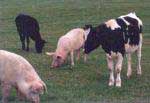 |
Combinations of cattle and pigs
Summary
Systems analysis
The model calculations showed the highest crop production in system 1 (dairy cattle at normal feeding level) of 56 hkg DM per ha against 33 hkg DM in system 2 (sows and finishing pigs) and 52 in system 3 (dairy cattle at low feeding level, sows and finishing pigs). The differences were primarily linked to crop rotation and clover grass share, but also to the level of plant accessible nitrogen to the cereal crops. The calculations showed that the three systems gave basis for an animal production per 100 ha of: system 1) 81 cows; 2) 71 sows and 3) 44 cows + 45 sows. The recorded average yield in 1997 and ’98 in the three systems varied from 42 to 67 hkg DM per ha with the lowest yields in the pig system and the highest in the cattle and the mixed systems, as anticipated from the model calculations. It is not possible to do a real test of the model calculations on the basis of these two year's registrations as the crop rotation was under establishment during the period. However, there was a surprisingly high yield in the cereal crops in the all-pigs system in consideration of the lower input of nutrients.
Milk production
The feeding of the dairy cows with clover grass and clover grass silage during the year without supplement of energy rich feed caused a significant reduction of the milk production and an extended interval between 1st and 2nd calving. Furthermore the milk quality got poorer as the milk had a lower content of protein and increased degree of acidity. By assignment of a restricted quantity of energy rich feed supplement, approx. 1/3, compared with the standard, the reduction in yield was, in contrast, surprisingly small, probably because the cows have been capable of compensating through a higher intake of grass and silage. At a reduced quantity of feed supplement, a positive influence was seen on the milk production and milk protein content of supplementary feed with protein of low degradability to clover grass silage but not to fresh clover grass. The results concerning grazing behaviour indicate that the cows not assigned the feed supplement selected the easily digestible parts of the crop more intensively, and to a larger extent avoided the structure rich and heavier digestible culms than the cows assigned a normal level of feed supplement. The available data comprise a number of interesting perspectives but further analysis is needed.
Mixed grazing with heifers and pregnant sows
In first-time grazing heifers, mixed grazing reduced the intensity of infection with the nematode Ostertagia ostertagi which normally will provoke clinical symptoms (diarrhoea, loss of weight) in the late summer. However, mixed grazing had no measurable effect on the sows’ contamination with nodular worms. There were no parasitological differences between alternate and mixed grazing. The results concerning grazing and silage for pregnant sows showed that a considerable share of the sows’ feed requirements could be covered through grazing of clover grass or through access to clover grass silage. The feed value by grazing corresponded in this project to 6.2 – 9.3 MJ NE per day, whereas the value of consumed silage corresponded to 6,9 – 10,8 MJ NE per day. The grass quality was significantly better by mixed grazing than by grazing with only sows, and at the same time the growth of both the heifers and the sows was significantly higher in the mixed grazing system than in the systems with separated species. Surprisingly, the grass quality was poorer and the clover share reduced at grazing with only sows on high stocking rate compared with normal stocking rate. According to the practical experiences, there were no behavioural problems with mixed grazing between the two species.
Estimation of grass intake by the alkane method
The experiments showed that the alkane method was suitable for determination of feed intake and digestibili-ty of clover grass in both cows and sows if it was possible to estimate an exact botanical composition of the intaken feed. Application of the C29/C32 alkane pair gave the most exact estimates. Determination of the botanical composition of intaken plant material was, on the other hand, uncertain. The analysis and calculation methods are therefore being further developed to comprise long chained alcohols, and in future this technique is expected considerably to contribute throwing light on essential aspects relating to grazing.
|